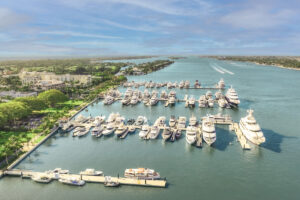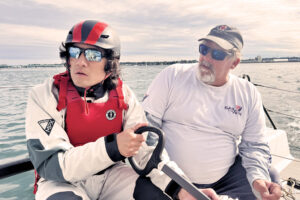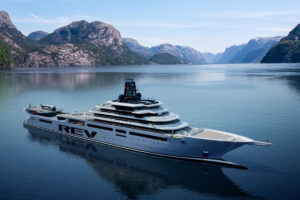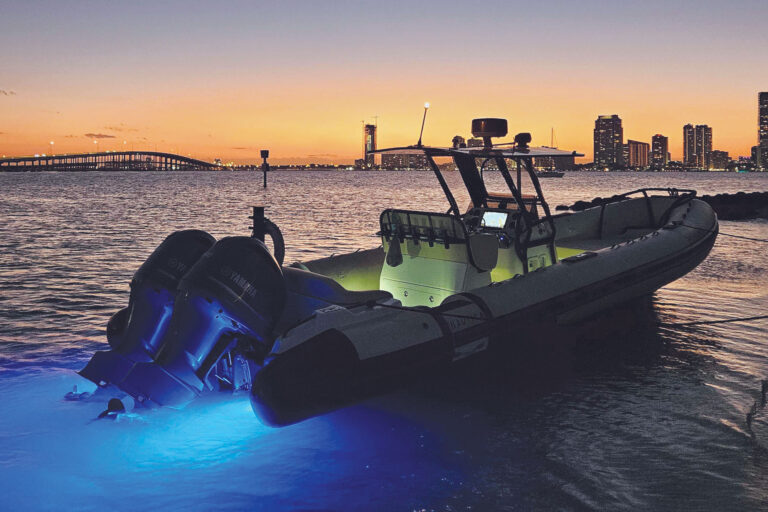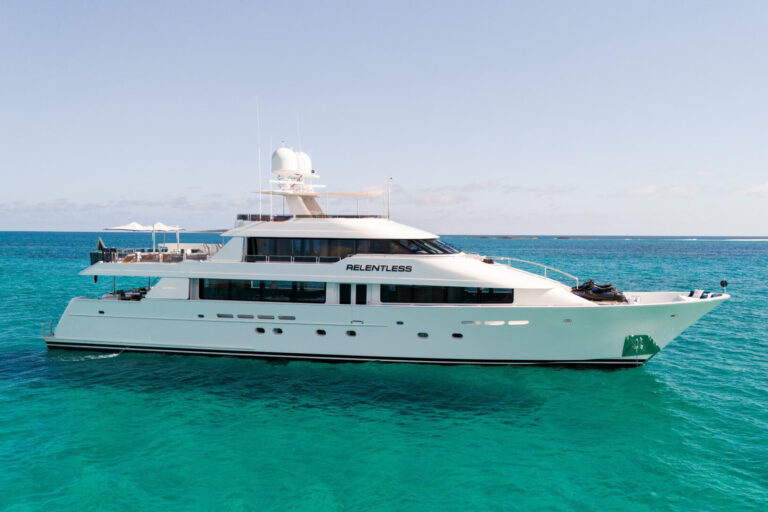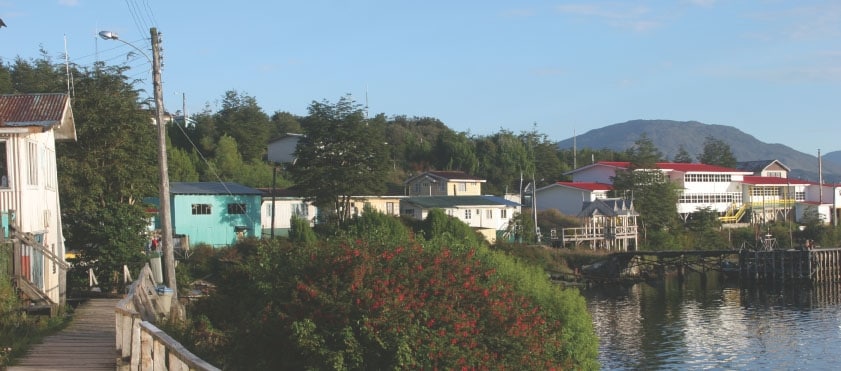
The Mehaffy’s flew down to the tip, visitng Puerto Eden and points south in the Chilean archipelago, in rare mild weather.
One January morning at the height of summer in the Southern Ocean, we steamed toward the end of the world. A high marine layer veiled the sunlight, while a thicker, less filmy layer concealed the tops of the peaks of the rocky headland to port, the one the locals call Cabo de Hornos. Between us and the chiseled cliffs giant petrels and imperial cormorants circled in a ceaseless eddy, but that wasn’t the reason for our continued expressions of wonder.
No, the wonder of our rounding of this point in the Furious Fifties, where gales occur fully 200 days a year, with squalls over 62 mph reported in all seasons, was that we had any leisure at all to study the birds and the clouds and the point itself, the one we call Cape Horn.
Our being here was due to romance meeting pragmatism head-on. In the 10 years of our full-time cruise, we had discussed sailing to the Marquesas or continuing along the Pacific Coast of South America to Chile and the extensive archipelago of Patagonia and Tierra del Fuego, but we’d never entertained seriously the notion of taking Carricklee around Cape Horn. The accounts of this sailing adventure, from Charles Darwin and Richard Henry Dana to such contemporary small-boat sailors as the Smeetons and the Roths, had indeed inspired us-just not to follow in their sea tracks.
Two years ago, however, we’d crossed the equator offshore of Ecuador and soon thereafter moored our ketch at the Puerto Lucàa Yacht Club. Now we were within striking distance, if you paid no mind to the stories, but at Puerto Lucàa the stories were pretty uninspiring-one of the boats to depart sent back woeful tales of beating into the prevailing southerlies and the powerful Humboldt current flowing northward, plus tangling with the myriad rules, regulations and fees the Peruvian government imposes on visiting sailors. The second cruising boat to leave PLYC near the same time chose to sail south by way of Easter Island, 1,800 miles to the southwest, expecting to explore that exotic island as well as to improve the point of sail for Chile. Anchored off Easter, they had such large swells day after day they were never able to leave the boat unattended and go ashore together. Departing from Easter, they set a course to fetch the coast of Central Chile, but the strong winds and huge seas resulted in a series of major equipment failures on their boat. They limped back to Puerto Lucàa for repairs and recuperation.
We also listened carefully to the stories from sailors who had crossed the Atlantic from Europe, cruised south along the east coast of South America, navigated the Estrechos de Magallanes to the Pacific, and then landed at PLYC. Despite having the prevailing winds and current behind them once in the Pacific, Harry, a sailor from the Netherlands, said of the difficulty of the passage north to Ecuador, “I never want to do it again!
So how did we end up here, a year and a half later-having embarked from Ushuaia, Argentina, the previous day and passed through Canal Beagle and Bahàa Nassau-offshore of Cabo de Hornos, gazing in wonderment instead of fear and trembling?
The answer is simple: We had opted for a vessel much larger than our puny Hardin 45 ketch, and a professional crew that rounds the Horn, on average, four or five times yearly. In Ushuaia we boarded Via Australis, of the Chilean company Cruceros Australis, for a five-day expedition south to the Horn and then north through the Chilean Archipelago to Punta Arenas. Normally we’d be the last people you’d ever see taking a cruise ship anywhere, but this was an Expedition Cruiser that would give us many of the same adventures we could have experienced had we sailed Carricklee to Chile, with few or none of the responsibilities and terrors. All this and, just as if we were aboard Carricklee, we had no dress code for dinner.
Once aboard, we sipped pisco sours as the captain reported that the weather so far looked favorable for rounding the Horn, lying about 60 miles southeast. However, he also reminded us that though he makes this run between Ushuaia and Punta Arenas weekly during the three to four months of summer, the weather only permits his taking the ship around the Horn three or four times a season.
Thus forewarned, we were content with no more than this possibility of a passage around Cabo de Hornos. After all, for almost 40 years after Sir Francis Drake first glimpsed the Horn (while being blown backward on an east-to-west passage through the more northerly Strait of Magellan), ships did not dare attempt it. The first to do so was merchant Jacob le Maire and master mariner Willem Shouten on the Dutch sailing ship Eendracht. Until the opening of the Panama Canal in 1914, thousands of merchant ships followed to make Drake Passage a critical link in the trade routes between the Atlantic and the Pacific. But more than 800 vessels also went down at this conjunction of the two great oceans.
On Via Australis we watched the captain maneuver us out of the harbor and eastward through Canal Beagle. Early sailing ship captains had feared this narrow channel strewn with rocks and rocky islets and subject to erratic williwaws; we could study majestic Martial Glacier receding off to starboard and Magellanic penguins and imperial cormorants diving for a late meal. After dark we passed tiny Puerto Williams, on Isla Navarino, on the Chilean side of the channel where the Chilean Navy maintains a small force to reinforce its sovereignty in Canal Beagle against the claims of rival Argentina.
The next morning, after donning our foul weather gear and buckling on our lifejackets, we gathered on the aft deck to climb into 20-passenger rubber sport boats to go ashore on Isla Hornos. In the drizzle, we climbed from the rocky shelf of a beach up 130 rickety steps zigzagging to a small plateau, the site of one of the Horn lights alongside a small weathered wooden shack all boarded up. From there we ascended another quarter-mile by boardwalk, many of its slats broken or missing, sometimes in entire sections, to the memorial erected for the thousands of sailors that have been lost at Cabo de Hornos. From the site of the monument we looked across a small inlet to the southernmost headland of the Horn (translated into Spanish as Hornos, or “Ovens).
Only after this early excursion ashore did the captain announce the conditions remained calm enough to complete the rounding of the Horn. Indeed, the wind was 8 to 10 knots; neither white caps nor icebergs disturbed the gray ruffling of the seas in Drake Passage. While we may have accomplished a legendary feat the easy way, and even then by luck, we nonetheless felt a kinship with all those sailors before us who had won the right to wear the symbolic earring (and to put one foot up on the dining table).
By that afternoon, Via Australis was returning northward through Bahàa Nassau. At Isla Navarino, we once again suited up, this time to go ashore in Wulaia Cove. Here one of the four pre-Hispanic groups living along this southern coastline when the Europeans arrived had left behind extensive shell middens. These hardy Yámanas, now extinct, had survived in this harsh, frigid environment for centuries without the protection of any clothing, instead covering themselves with seal oil. Nomads, they depended primarily on mussels and seals for nourishment, the women the divers and the men the hunters.
When we returned to the beach in Wulaia Cove, the ship’s crew was waiting with a table set up with bottles of soda and Johnny Walker, to be poured over glacial ice in glass tumblers, along with hot tea served in real china cups.
By the next morning we were up and on deck for early coffee at 0600 to marvel at the impressive parade along what is called the Avenue of Glaciers. The following morning the Via Australis carried us to Isla Magdalena, a state-protected island where each October to March upwards of 60,000 mating pairs of Magellanic penguins reside. On this, our last excursion ashore, we followed a path around the island past adult penguins and chicks, some in or near their nesting burrows, others making their way down to or up from the water.
Thus ended our cruise, leaving us with just the slightest nagging feeling about not adding Carricklee to the short list of small boats that have rounded the Horn, beginning with Connor O’Brien’s Saoirse in 1923-a regret that was still far from enough to encourage us to plan a passage on our own.

